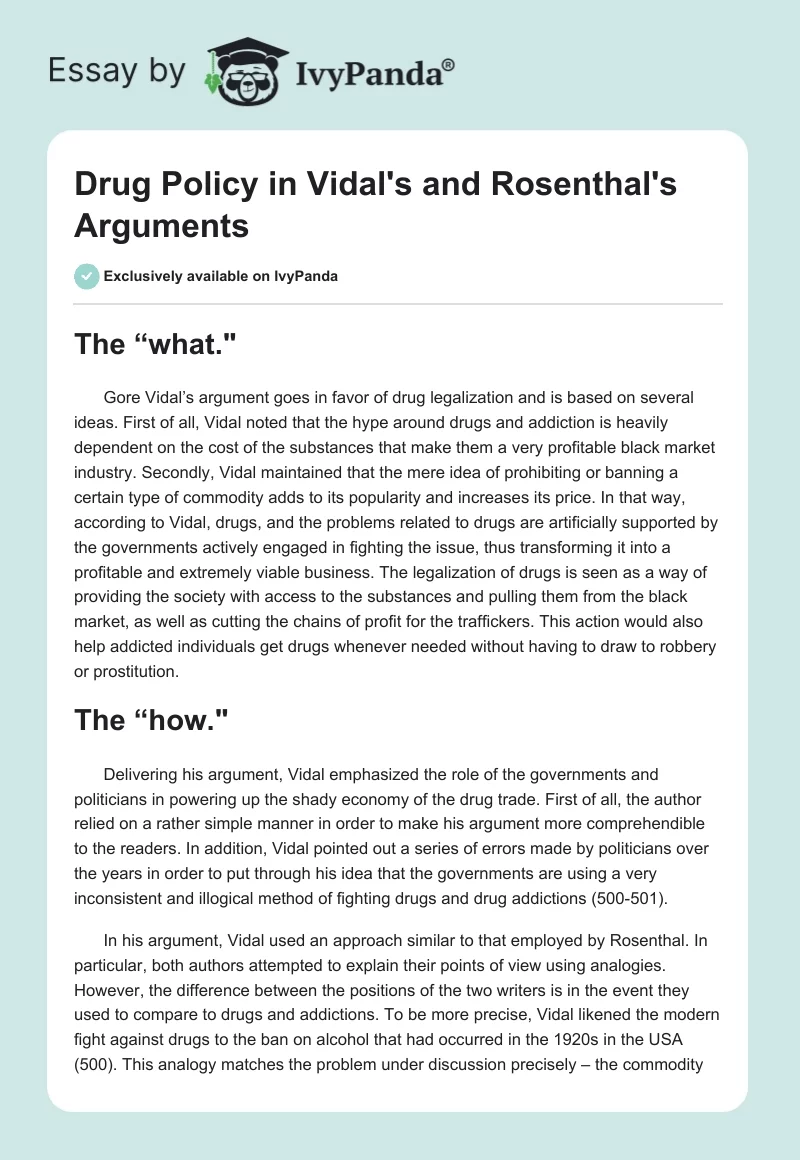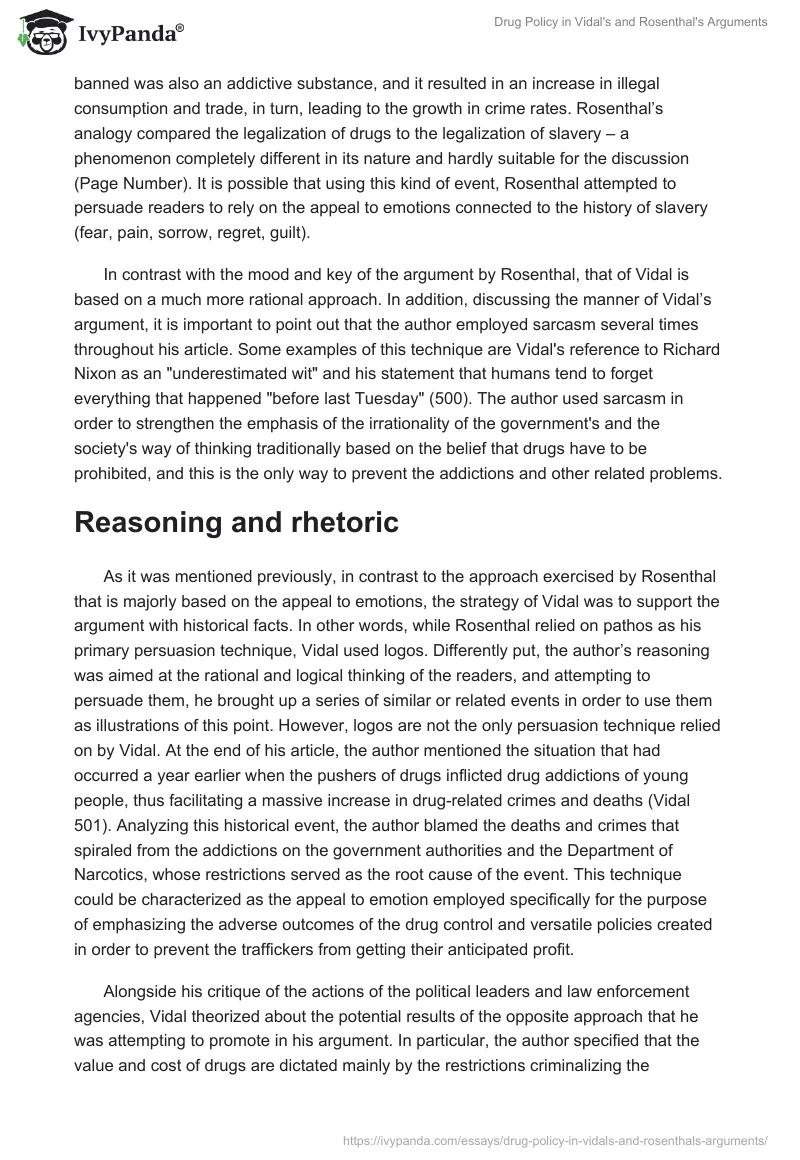The “What”
Gore Vidal’s argument goes in favor of drug legalization and is based on several ideas. First of all, Vidal noted that the hype around drugs and addiction is heavily dependent on the cost of the substances that make them a very profitable black market industry. Secondly, Vidal maintained that the mere idea of prohibiting or banning a certain type of commodity adds to its popularity and increases its price.
In that way, according to Vidal, drugs, and the problems related to drugs are artificially supported by the governments actively engaged in fighting the issue, thus transforming it into a profitable and extremely viable business. The legalization of drugs is seen as a way of providing the society with access to the substances and pulling them from the black market, as well as cutting the chains of profit for the traffickers. This action would also help addicted individuals get drugs whenever needed without having to draw to robbery or prostitution.
The “How”
Delivering his argument, Vidal emphasized the role of the governments and politicians in powering up the shady economy of the drug trade. First of all, the author relied on a rather simple manner in order to make his argument more comprehendible to the readers. In addition, Vidal pointed out a series of errors made by politicians over the years in order to put through his idea that the governments are using a very inconsistent and illogical method of fighting drugs and drug addictions (500-501).
In his argument, Vidal used an approach similar to that employed by Rosenthal. In particular, both authors attempted to explain their points of view using analogies. However, the difference between the positions of the two writers is in the event they used to compare to drugs and addictions. To be more precise, Vidal likened the modern fight against drugs to the ban on alcohol that had occurred in the 1920s in the USA (500). This analogy matches the problem under discussion precisely – the commodity banned was also an addictive substance, and it resulted in an increase in illegal consumption and trade, in turn, leading to the growth in crime rates. Rosenthal’s analogy compared the legalization of drugs to the legalization of slavery – a phenomenon completely different in its nature and hardly suitable for the discussion (Page Number). It is possible that using this kind of event, Rosenthal attempted to persuade readers to rely on the appeal to emotions connected to the history of slavery (fear, pain, sorrow, regret, guilt).
In contrast with the mood and key of the argument by Rosenthal, that of Vidal is based on a much more rational approach. In addition, discussing the manner of Vidal’s argument, it is important to point out that the author employed sarcasm several times throughout his article. Some examples of this technique are Vidal’s reference to Richard Nixon as an “underestimated wit” and his statement that humans tend to forget everything that happened “before last Tuesday” (500). The author used sarcasm in order to strengthen the emphasis of the irrationality of the government’s and the society’s way of thinking traditionally based on the belief that drugs have to be prohibited, and this is the only way to prevent the addictions and other related problems.
Reasoning and Rhetoric
As it was mentioned previously, in contrast to the approach exercised by Rosenthal that is majorly based on the appeal to emotions, the strategy of Vidal was to support the argument with historical facts. In other words, while Rosenthal relied on pathos as his primary persuasion technique, Vidal used logos. Differently put, the author’s reasoning was aimed at the rational and logical thinking of the readers, and attempting to persuade them, he brought up a series of similar or related events in order to use them as illustrations of this point.
However, logos are not the only persuasion technique relied on by Vidal. At the end of his article, the author mentioned the situation that had occurred a year earlier when the pushers of drugs inflicted drug addictions of young people, thus facilitating a massive increase in drug-related crimes and deaths (Vidal 501). Analyzing this historical event, the author blamed the deaths and crimes that spiraled from the addictions on the government authorities and the Department of Narcotics, whose restrictions served as the root cause of the event. This technique could be characterized as the appeal to emotion employed specifically for the purpose of emphasizing the adverse outcomes of the drug control and versatile policies created in order to prevent the traffickers from getting their anticipated profit.
Alongside his critique of the actions of the political leaders and law enforcement agencies, Vidal theorized about the potential results of the opposite approach that he was attempting to promote in his argument. In particular, the author specified that the value and cost of drugs are dictated mainly by the restrictions criminalizing the substances and their use. In that way, the only way to remove the value is to legalize drugs and provide everyone with permission to buy them. Also, the author added that informing the society about the harm caused by drugs is another task necessary for the minimization of hype around their availability.
Evaluation of the Argument
The use of historical facts and references is definitely the strong feature of Vidal’s argument. Additionally, the success of Vidal’s writing can be attributed to the appropriate selection of an analogy, helping to illustrate the wrongness of restrictions and prohibitions as the methods of fighting against the use and trade of addictive substances.
At the same time, when it comes to the weakest features of the argument, one could notice that Vidal emphasized that the use of drugs could be controlled by the population itself just with the help of honest and detailed information as to the consequences of addictions. The author did not seem to mention that many of the modern drug users are fully aware of the dangers of addictions, and this does not stop them from using. Additionally, making his point about the individuals’ right to harm and kill themselves, Vidal did not take into consideration the fact that drug addictions result in aggressive and violent behaviors of the intoxicated persons and may lead to the harm caused to the people around. Moreover, offering the legalization of all types of drugs known to science, Vidal did not cover the craze that would start right after such legalization in a society that is used to drugs being prohibited.
As a recommendation for the next step, it is possible to mention the experiences of the countries where some types of drugs have been legalized for some time and draw conclusions from this approach as the one that is more (or less) effective than the criminalization of the substances.
Works Cited
Rosenthal, Mitchell. “The Case for Slavery.” Thinking Critically, edited by John Chaffee, Cengage Learning, 2014, pp.
Vidal, Gore. “Drugs.” Thinking Critically, edited by John Chaffee, Cengage Learning, 2014, pp. 500-501.

 4.00
4.00
